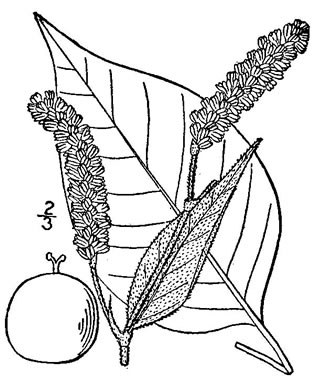Spermatophytes (seed plants): Angiosperms (flowering plants): Eudicots: Core Eudicots: Caryophyllales
WEAKLEY'S FLORA OF THE SOUTHEASTERN US (4/24/22):
Persicaria orientalis
FAMILY
Polygonaceae
Go to FSUS key
Dig deeper at SERNEC, a consortium of southeastern herbaria.
Check out EDDMapS.org to see where this has been reported.
Read more about Kiss-me-over-the-garden-gate at Vascular Plants of North Carolina.
SYNONYMOUS WITH
PLANTS NATIONAL DATABASE:
Polygonum orientale
FAMILY
Polygonaceae
SYNONYMOUS WITH Flora of North America north of Mexico, vol. 5 (2005)
Persicaria orientalis
SYNONYMOUS WITH VASCULAR FLORA OF THE CAROLINAS (Radford, Ahles, & Bell, 1968) 063-04-010:
Polygonum orientale FAMILY Polygonaceae
SYNONYMOUS WITH Manual of the Southeastern Flora (Small, 1933, 1938)
Persicaria orientalis
COMMON NAME:
Kiss-me-over-the-garden-gate, Prince's Feather, Prince's-plume, Princess-feather
To see larger pictures, click or hover over the thumbnails.
WEAKLEY'S FLORA OF THE SOUTHEASTERN US (4/24/22):
Persicaria orientalis
FAMILY
Polygonaceae
SYNONYMOUS WITH
PLANTS NATIONAL DATABASE:
Polygonum orientale
FAMILY
Polygonaceae
SYNONYMOUS WITH
Flora of North America north of Mexico, vol. 5
Persicaria orientalis
SYNONYMOUS WITH
VASCULAR FLORA OF THE CAROLINAS (Radford, Ahles, & Bell, 1968) 063-04-010:
Polygonum orientale
FAMILY
Polygonaceae
SYNONYMOUS WITH
Manual of the Southeastern Flora (Small, 1933, 1938)
Persicaria orientalis
If a search such as "Carex leptalea var. leptalea" doesn't deliver the results you want, try "Carex leptalea".
Or, to minimize chances of a misspelling, try just "Carex le".
Less is more: If "pencil flower" doesn't deliver the results you want, try "pencil".


